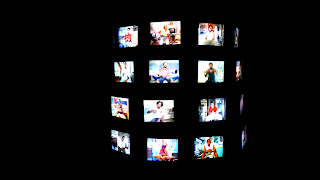One of the most interesting installation pieces I saw, of many that depict a room, or living space (most will be featured on another post), was the one created by Anna Maria Maiolino (Italy, 1942). Radicated in Brazil since the 60s, Maiolino's Arroz com Feijão (Rice and Beans) was first made during the dictatorship, and has been reassembled many times ever since democracy was reinstated.
Marcius Galan (USA, 1972)'s Ponto em escala real (Dot in real scale) presents a literal transposition of a point in the map of the city that uses a 1/130,000, reconstructed it in this new environment to its actual scale.
Tatiana Trouvé (Italy, 1968)'s work 350 Points toward Infinity comes with a warning. The magnetic field hidden in the floor of her installation space, which holds multiple pendulums as if they were in mid-swing, could potentially offset pace-makers. A secondary and less threatening warning is the slight plumber's crack on display by the Biennial staff that was cleaning the piece when I photographed it (it being the work, not the crack).
More than once I ran into the cleaning crew, who incessantly cleaned the place, no small feat given the spareness of the building the the shedding quality of some artworks, such as Cinthia Marcelle (Brazil, 1974)'s Sobre este mesmo mundo (This same world over). Her work made me think of how William Kentridge's studio might look like, but with charcoal dust instead of chalk.
A good segue-way to that Kentridge reference is Qiu Anxiong (China, 1972)'s animated drawings titled The New Classic of Mountains and Seas Parts 1 and 2, which were shown as three projections, though this work possesses its own merits.
While some works were immersive in their subject and pace, some works actually required its audience to enter and navigate through its interior, such as Henrique Oliveira (Brazil, 1973)'s A origem do terceiro mundo (The origin of the third world). As one exited this piece (paging Courbet), the gathering of smiling faces on that end made one look back, join the group, and enjoy the impending surprise.
Fittingly placed near one another were artists Antonio Manuel (Portugal, 1947) and Gustav Metzger (Germany, 1926). Their work used concealment and audience participation as a means of unveiling to deal with political topics, from different times and places. Manuel's flans are concealed by cloths that can be moved from ceiling pulleys.
Of a larger scale, Metzger's To Crawl Into - Anschluss, Vienna, March 1938 was displayed in front of it on the floor, covered by a yellow fabric.
Towards the end of my second visit to the Biennial, a day before its closing date, I ran into Yoel Diaz Vázquez (Cuba, 1073)’s video installation La torre del ruído (The tower of noise), which was one of my favorites. Unfortunately I ran out of memory space in my card, so only this small snippet of video is available.
Rosangela Rennó (Brazil, 1962) uses the object-ness of the photograph, and related apparatus, in her installation Menos-valia (Worth-less). On the day between my viewings a live auction took place, so upon my return the majority of the artifact on display was gone.
Another manner in which multiple video screens were presented were via multiple projections in a darkened room (my least favorite mode, I’m a fan of television monitors). Two that come to mind that transcended my bias centered on the relationship of body and space, in and out of the image. Kutlug Ataman (Turkey, 1961) presented Beggars, perhaps a contemporary take on (or result of) Sam Taylor-Wood’s Third Party.
Amar Kanwar (India, 1964)’s The Lightning Testimonies also employ multi-screen projections, but with the different pacing in the videos and intermixing of audio channels.
Last but not least, another favorite of mine (which did not make it to the well-known section of part 1), Cildo Meireles (Brazil, 1948) featured two different bodies of work. The early Projeto Cédulas (Quem matou Herzog?) [Project Bills (Who killed Herzog?)], where real currency was changed and reintroduced into the world was almost lost in a small room filled with other three artists’ works (Hélio Oiticica, Artur Barrio, and Sandra Gamarra), a real disservice to everyone involved in that section on the third floor. In a better spot, near the temporary home of MAC (Museo de Arte Contemporanea), a new installation simply titled Abajur (Lamp) invites viewers into a circular walk up enclosed environment, where a large photorealistic diorama of an ocean, with birds and clouds, slowly moves, lit from within. As one walks around the space a colonial imperial vessel appears. Upon close inspection, below deck so to speak, one sees three or four young men moving a mill, that activates the motion of the space.





































No comments:
Post a Comment